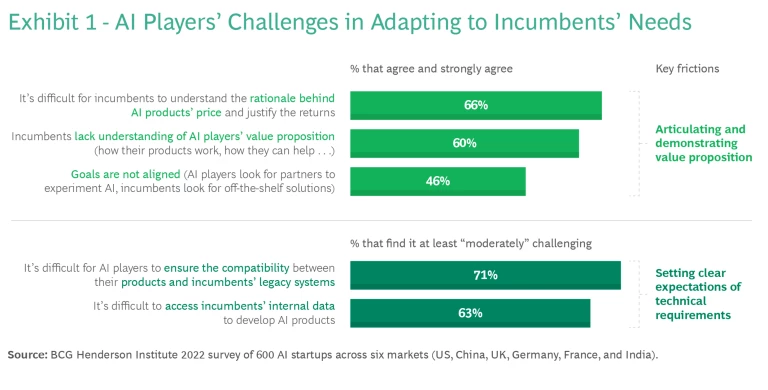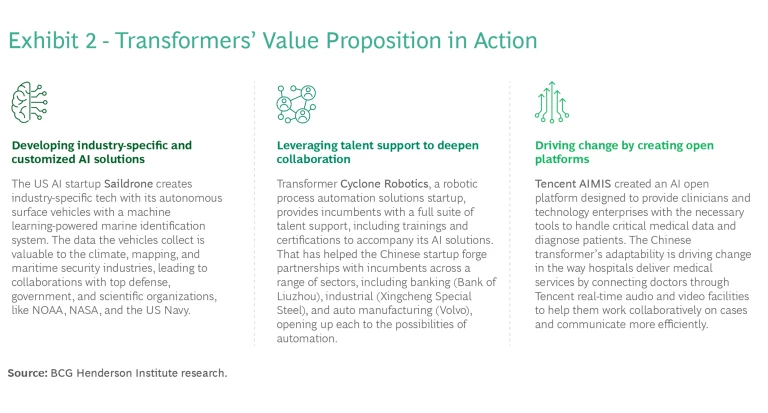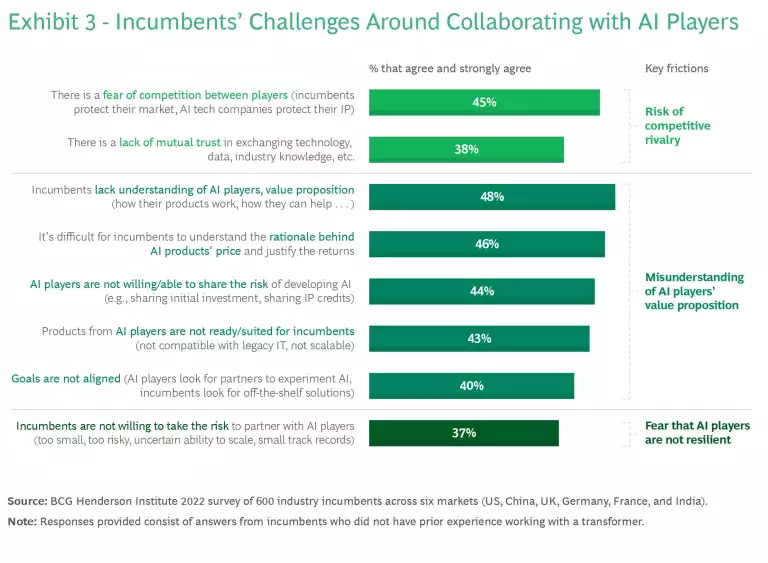For AI startups providing AI solutions to businesses, the road to success runs through incumbent industries. Established companies have the resources, data, and problems in need of solving that can catapult a startup toward growth and financial stability. But many incumbents are reluctant to team up with AI players, especially upstarts. How can AI players overcome this skepticism?

Our survey of 600 incumbent business leaders and 600 AI startups and scaleups found that many AI players are struggling to adapt their value proposition to incumbents’ needs—or to articulate their value proposition effectively. (See Exhibit 1 and methodology.) Incumbent leaders point to a lack of trust and understanding of AI players and their offerings.
AI players have two priorities as they set out to find partners: ensure they can stand out from the crowd of other technology providers by focusing on what incumbents need most and proactively address incumbents’ reservations about forming partnerships. Those that achieve both can become transformers—companies (typically startups and scaleups) that go well beyond developing the best AI tech, providing customized technology solutions to a specific industry or functional problem, helping incumbents build the right talent base, and driving organizational change.
Transformers are consistently granted greater access to incumbent data and industrial knowledge, allowing them to build more competitive AI solutions that can improve how an entire industry operates. Transformers have much to gain—and to lose if their competitors act first—making it imperative for AI players to play this role.
How Transformers Stand Out—and Benefit
Incumbents’ main challenges to AI adoption are technology, talent, and change management. AI startups should therefore focus their offering around providing these three particular ingredients—which are the foundation of a transformer’s value proposition. (See Exhibit 2.) And each provides a critical benefit to the AI player’s growth trajectory.

Creating Compatibility with Customized AI Solutions
Of the incumbents we surveyed, 75 percent find it difficult to identify internally the tools needed to build an AI solution. Transformers address this challenge by including in their offering customized AI solutions, enabled by the fact that they often operate in a single industry or address a specific function across industries. This expertise allows them to tackle business problems faced by industry incumbents and help incumbents recover their technology debt.
The benefit for transformers of providing this bespoke support is that it creates an environment where the transformers’ solutions are more likely to be understood—and implemented. Our survey found AI players who behave as transformers by providing custom technology are two times less likely to be slowed down by incumbents’ compatibility issues with their legacy systems. With less wasted time, transformers’ attention can be invested in more fruitful tasks such as model experimentation and training toward optimal levels of accuracy.
Gaining Access to Data and Insights Through Talent Support
We also found that 83 percent of incumbents cited finding talent that know how to work with AI as a challenge to AI adoption. Transformers provide access to the talent pool incumbents desperately need and help train the incumbents’ employees to develop AI and work with it. In addition, because transformers often specialize in industries/functions, they speak a similar language as incumbents, which facilitates the employee upskilling process.
By sharing critical capabilities like access to AI tech talents and trainings, transformers create a mutually beneficial environment. Our survey showed that when AI startups or scaleups opened their talent pools, incumbents reciprocated, making AI players about 70 percent more likely to get access to necessary data. When AI players went a step further, providing training support, they were 50 percent more likely to have the incumbent share substantial industry insights. This data and insight enable transformers to continuously improve their customization—creating a virtuous circle with their incumbent partner.
Securing Funding with Change Management Support
Eighty-three percent of incumbents surveyed also said the changing complex operations and processes to work with AI and scale it posed at least a moderate challenge for their ability to adopt the technology. By gaining a deep understanding of the incumbent’s operations, transformers can craft their AI strategies across business units, drive mind-set changes across the organization, and help incumbents reinvent their business models/operations with AI.
AI startups or scaleups that help manage the incumbents’ organizational change are 70 percent more likely to secure incumbent funding to share the costs of AI development projects. Unlike talent, where startups help train incumbent employees to make sure the solution is used, change management support is about committing to the financial success of the adoption. Startups invest time redefining clients’ processes to make sure the incumbents can extract the most value out of the tool. For transformers, change management is about committing to help the incumbent grow in return for what startups themselves need to grow—funds.
Creating a Path to Collaboration with Incumbents
The benefits that AI players can offer incumbents are clear, yet many still struggle to be seen—and heard. In our survey, 80 percent of the AI startups we identified as transformers reported that “getting the right visibility for their products” posed a challenge. And nearly two-thirds (64 percent) of transformers found that incumbents’ lack of understanding of their value proposition created an obstacle to meaningful collaboration.
When we spoke to decision-makers at incumbents that had not collaborated with a transformer about how they viewed AI startup or scaleup collaboration, time and again they reported frictions in three key areas: risk of competitive rivalry, not understanding AI players’ value proposition, and concerns about AI players’ resilience. (See Exhibit 3).

Tackling Risk of Competitive Rivalry
Roughly one-third (38 percent) of incumbents that had not collaborated with a transformer reported lack of mutual trust as a challenge to successful collaboration. This lack of trust makes incumbents reluctant to share their data and privileged industry knowledge, both of which are critical for AI startups to build a tailored solution. Nearly half of incumbents (45%) that have not yet collaborated with a transformer also said they feared market competition from AI players, pointing out that AI players are not transparent with their technology and guard their IP.
Shift the incumbent mind-set. To overcome incumbents’ aversion to collaboration, AI players need to act as illuminators—putting a spotlight on the benefits of collaboration. Transformers will need to help to recast AI players so they are seen not as disruptive threats, but as allies that can help the incumbent to expand its market base.
Global software transformer Cognite frames its value proposition in a way that explicitly addresses the lack of understanding and trust. The startup has published a number of business cases that include key impact metrics and client testimonies. It also highlights outside analysts’ perspectives on its website to help incumbents understand its solutions, while offering potential clients a call with a data expert to address questions. In addition, Cognite set up online forums, user groups, and regular community events in which the transformer showcases real-world use cases, highlighting how different companies are leveraging the platform to improve their operations, reduce costs, and enhance safety.
Advocate for transparency. Transformers need to push for increased transparency, particularly with contracts that establish clearly defined data rights, standards, control mechanisms, and mitigations. Transformers themselves should be transparent with incumbents on how the data required for AI is collected, used, and protected, and should reassure incumbents about their data governance and provide instruments to manage it.
When Google Cloud set out to create an AI-based claims process for US insurance company USAA, allowing it to make vehicle damage estimates from digital customer images, it invested in building trust in how it was collecting and processing the data and mitigating risk. It created extensive model risk documentation, demonstrating its experience with financial services risk management frameworks, while integrating with USAA’s model risk management services. As a result, USAA made available large strategic datasets, including millions of images, that led to a better AI solution.
Provide access to adjacent services. To further establish confidence-building in the partnership, transformers can provide services such as insurance on the AI solution and data utilization. This enables the incumbent to embrace AI, while also insuring them against any unexpected business disruption. Ultimately, this will allow incumbents to price risk more precisely, ensuring effective pay-out mechanisms, and providing a seamless risk management experience.
Japanese IT service provider Hitachi, for instance, partnered with insurance company Swiss Re to offer a digital insurance product for its clients in manufacturing and transportation. By providing the coverage and minimizing client risk in the case of unexpected AI-related businesses disruptions (for example, faulty or inoperative algorithms in critical processes and operations controlled by AI), the transformer was able to build incumbents confidence in pursuing AI solutions.
Shaping Expectations of Value Proposition
Nearly half (48 percent) of incumbents that have not yet collaborated with a transformer said they didn’t understand transformers’ value proposition. This lack of familiarity is a clear obstacle to collaboration for transformers, as 43 percent of these incumbents think AI products aren’t ready and 46 percent reported not understanding the rationale behind the pricing of those AI products. Another 44 percent of incumbents that have yet to engage with a transformer also believe that AI startups or scaleups are either unwilling or unable to assume the necessary risk of partnership. This perception of risk asymmetry and lack of alignment on goals holds back engagement for 40 percent of non-collaborating incumbents.
Prove the value of collaboration. Transformers need to take the lead in guiding incumbents, addressing the common pitfalls, and demonstrating, from start to finish, the potential of collaboration. This includes clearly highlighting the range of their product offerings and the value potential of their solutions if scaled. Transformers also need to show their ability to integrate and customize the solution to address the client’s specific business problem. That requires showing an in-depth knowledge of the incumbent’s data and analytics infrastructure that enables the collection, analysis, and utilization of data that incumbents can plug into. One way to demonstrate faith in their own solution is for transformers to incentivize incumbents by offering trial periods on product adoption.
The travel and transportation technology company FLYR Labs, for instance, created a 12-week adoption program with different stages—data implementation, system set-up, testing and training, and performance validation—during which potential clients can experiment before making a final decision on whether to purchase and integrate the solution. This method of sharing clear implementation plans and allowing for experimentation has attracted collaborations with incumbent carriers Singapore Airlines and Air New Zealand.
Transformers need to take the lead in guiding incumbents, addressing the common pitfalls, and demonstrating the potential of collaboration.
Develop, test, and commercialize solutions. Transparency helps showcase AI players’ willingness to co-develop an AI solution with the incumbent and build a win-win partnership. Demonstrating the capacity to register quick wins also helps build momentum. It’s important, however, to be upfront about the associated methodology and realistic about the timeline for capturing them, which, if done transparently, can be another form of persuasion to motivate incumbents to experiment with a transformer.
SandboxAQ, for example, invests heavily in customer support and education, offering its incumbent financial services clients training to help them understand the way the transformer’s end-to-end crypto-agile security suite works. By establishing a clear delivery plan, the AI player is able to commit to delivering effective progress on a daily basis. SandboxAQ recognizes that “ability to deliver fast” as a competitive advantage in winning long-term contracts with major US banks.
Open the black box on pricing. To win over incumbents, transformers will have to be transparent about pricing, highlighting the rationale behind their products’ prices, including whether they are value-based, competition-based, or cost-based. Third-party appraisals or value generation simulators specific to the solution can help in backing up the logic of their price point.
Marketing analytics startup Adverity, for example, commissions Forrester Consulting to provide prospective clients with a potential return-on-investment assessment of adopting Adverity’s end-to-end data and analytics platform. Google Cloud, on the other hand, includes a pricing calculator tool that allows would be clients to input their specific requirements and estimate their cloud savings.
Lay out commitments. Transformers should highlight their commitments in the partnership, including financial pledges, IP-related obligations, such as exclusivity rights, as well as commitments to provide training hours, talent recruitment quotas, and AI strategy guidance deliverables.
As SandboxAQ executive told us, “There is a real appetite for our clients to understand and be trained on solutions. Whenever we provide them with the option [for this training], they immediately seek this support throughout the organization.”
Showcase the ability to scale. It’s also vital to showcase AI players’ ability to scale AI across the client’s organization. This gives the transformer the opportunity to show a robust understanding of the use cases across the incumbent’s business, as well as demonstrate the replicability potential of its AI products.
The open-source machine learning platform H2O.ai was able to grow an experimental partnership with Commonwealth Bank of Australia (CBA) into a full-scale collaboration across the organization. Given the opportunity to pilot its solution, H2O.ai showcased its ability to scale tech, distributing 100 licenses across business units with more than 20 uses cases. The startup similarly scaled talent, training more than 1,000 CBA workers on its tools and upskilling another 170 staff to experiment and build models on the platform that tackle business problems ranging from cyber-threat detection to cash optimization. The transformer also supported CBA in scaling change, providing the bank with a dedicated team of experts, machine learning engineers, and product specialists, all to work full-time on developing new AI solutions within the bank processes.
Asserting AI Players’ Resilience
Incumbents that have not collaborated with a transformer frequently have concerns about the resilience and capabilities of AI players—startups, in particular. Thirty-seven percent of these incumbents worry that AI startups or scaleups are too small, their futures too uncertain, and their ability to scale too untested.
Form alliances and seek out ecosystems. To address incumbents’ concerns, transformers can provide insight and guidance to help incumbents enlist additional AI partners. By assisting incumbents in onboarding complimentary AI players, the startups can amplify their value in a network of AI innovation. This is important because, for incumbents, AI has changed the nature of competition, shifting it from companies versus companies to competition between ecosystems of collaborative partners. Transformers can improve their positioning to partner with incumbents by joining an ecosystem, demonstrating its competitive advantages and being a catalyst for incumbents to join.
The AI open platform ALEIA, for example, is a collaborative development platform with data sets and models that other startups can use to develop algorithms more quickly. ALEIA brings together French and European technology service providers—such as QWAM Content Intelligence, Geo4Cast, and ITrust—on data services and cybersecurity, which helps startups developing AI products on the platform offer complementary end-to-end products, making them more robust and desirable to collaborate with in the eyes of incumbents. The data services company Artefact, on the other hand, works with more than 300 leading international brands, from Orange to L’Oréal, and Sanofi, helping each of them scale their AI solutions. The transformer also created open-AI ecosystems for particular areas, such as finance and health, thus increasing their value to clients by giving them access to a large pool of potential tech partners.
Partner with a tech giant. These partnerships can offer a greater combination of capabilities and expertise in building and deploying AI-customized solutions. Tech giants, which will be more familiar with a transformer’s value proposition, will be able to benefit from the smaller AI partner’s vertical tech knowledge, while AI players benefit from the reputational advantage of tech giants.
The entire portfolio of application software transformer C3 AI, for example, is integrated and optimized for Google Cloud infrastructure, making it easier and more secure for traditional companies to run C3 AI solutions.
Support risk assessment. Transformers can also buttress their offering by providing support for the incumbent’s risk assessment. They can do this by providing incumbents with financial data, legal data, and access to the board of directors to help them assess the risks and opportunities of collaborating with them.
Stay ahead with BCG insights on artificial intelligence
SandboxAQ emphasizes that the risk assessment stage is a crucial moment for incumbents in deciding whether to collaborate with a startup. To meet this moment, SandboxAQ is deeply involved in the due diligence process, bringing in historical investors or proposing concrete mitigation solutions to the risks inherent to the technology. In 2022, the company was chosen by the US National Institute of Standards and Technology (NIST) as a collaborator for a National Cybersecurity Center of Excellence project on migration to post-quantum cryptography, bolstering its profile as a robust technology partner. Fellow startup H2O.ai showcased its robustness a different way—appointing CBA’s chief data and analytics officer to its Board. The case of H2O.ai shows how risk-sharing in a collaboration can take the form of partners strengthening common governance.
By meeting incumbents’ holistic needs and addressing their reservations, AI players can open the door to meaningful collaboration. By taking on the role of transformers, AI players can help incumbent firms to improve their AI adoption initiatives while gaining access to the data and insights that will enable themselves to achieve sustained growth.
Methodology
To gain insight into AI startups and scaleups’ collaboration experiences with incumbents adopting AI, BCG Henderson Institute surveyed 600 incumbent business leaders and 600 AI startups and scaleups across six markets—US, China, UK, Germany, France, and India. In addition, we conducted interviews with industry leading incumbents and AI startups or scaleups across a range of industries, including automotive, insurance, and pharma. The 2022 survey and interviews aimed to understand what challenges AI players face when partnering with and building solutions for incumbents and how best to overcome roadblocks to incumbent adoption.






